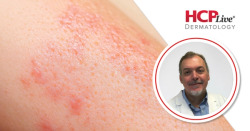
OR WAIT null SECS
Quitting Smoking Lowers Risk of Hidradenitis Suppurativa, New Study Reveals
A study involving 6.2 million patients found smoking increases the risk of developing hidradenitis suppurativa, with quitting smoking significantly reducing this risk.
A new study is shedding further light on the association of smoking with the development of a common dermatologic condition.
The study, which included more than 6.2 million patients, concluded smoking was associated with an increased risk of developing hidradenitis suppurativa, with results indicating a lower risk of developing the condition was observed for those who had quit after the first study visit, those who quit prior to joining the study, and those who never smoked when compared to current smokers.1
“In a regular practice setting with long-term observation, we found that those who quit smoking had a reduced risk of [hidradenitis suppurativa] development. This implies that quitting smoking may hinder the onset of [hidradenitis suppurativa] and could have a substantial affect on [hidradenitis suppurativa] prevention,” wrote investigators.1 “An interesting point is that the [hidradenitis suppurativa] risk-reduction effect observed in smoking quitters was as remarkable as the [hidradenitis suppurativa] risk reduction observed in sustained ex-smokers. This suggests that smoking may have a fairly acute effect on [hidradenitis suppurativa] pathogenesis, highlighting the importance of quitting smoking as quickly as possible.”
A cornerstone in the prevention strategies for a slew of chronic, metabolic diseases, smoking cessation and abstention remains a tenet of healthcare. As investigators of the current study, who were led by Seong Jin Jo, MD, PhD, of Seoul National University College of Medicine, point out, much less research has been dedicated to the effect of smoking cessation on dermatologic conditions. With this in mind, investigators designed their research endeavor as a population-based cohort study leveraging data recorded within the Korean National Health Insurance Service database.1
For the purpose of analysis, investigators included individuals who had undergone 2 consecutive biennial health examinations from 2004 to 2005 and 2006 to 2007 for the primary cohort of the study. Investigators also included a secondary cohort of individuals who underwent all biennial health examinations and maintained the same smoking status from 2006 to 2007 through the end of the follow-up period. The study’s follow-up period began on January 1, 2008 and ended either on the occurrence of an HS event, death, or December 31, 2021, whichever came first.1
A total of 6,230,189 individuals with a combined 84,457,025 were enrolled in the primary cohort. This cohort had a mean age of 47.2 (SD, 13.5) years and 55.6% were male. During the follow-up period, a total of 3761 hidradenitis suppurativa events occurred among the primary cohort.1
Of note, 1,905,499 participants who underwent all biennial health checkups throughout the follow-up period and maintained a consistent smoking status until the end of the follow-up period were enrolled in the secondary cohort.1
Results of the investigators’ primary analyses suggested a reduced risk of hidradenitis suppurativa was observed among those who confirmed to smoke initially but quit by the second checkup (adjusted hazard ratio [aHR], 0.68; 95% Confidence Interval [CI], 0.56 to 0.83), those who maintained cessation status throughout (aHR, 0.67; 95% CI, 0.57 to 0.77), and never smokers (aHR, 0.57; 95% CI, 0.52 to 0.63) relative to those with a smoking history who continued smoking. Investigators highlighted patients who quit smoking but resumed by the second checkup and those who never smoked but began before the second checkup exhibited a comparable risk of hidradenitis suppurativa as their counterparts with a smoking history who continued smoking.1
Secondary cohort analysis results were aligned with those of the primary cohort, according to investigators. Before concluding, investigators called attention to results indicated the risk of hidradenitis suppurativa 3 to 4 years after smoking cessation resembled that of never smokers.1
In an editorial comment, Alexandra Charrow, MD, MBE, of the Department of Dermatology at Brigham and Women’s Hospital, and Leandra Barnes, MD, of the Department of Dermatology at the Stanford University School of Medicine, offered additional insight into the known relationship between smoking cessation, gaps in our current understanding, and next steps for research.2
“Kim et al meaningfully contribute to the understanding of smoking cessation as a primary prevention strategy for HS. However, more work is needed to understand whether smoking cessation may also have a role in secondary or tertiary prevention strategies for HS,” Charrow and Barnes wrote.2
References:
- Kim SR, Choi Y, Jo SJ. Smoking Cessation and Risk of Hidradenitis Suppurativa Development. JAMA Dermatol. Published online August 21, 2024. doi:10.1001/jamadermatol.2024.2613
- Charrow A, Barnes LA. Smoking Cessation and Hidradenitis Suppurativa: Advances and Treatment Gaps. JAMA Dermatol. Published online August 21, 2024. doi:10.1001/jamadermatol.2024.2612


